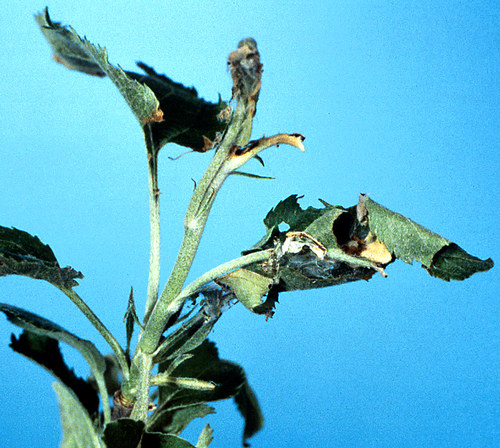The larvae of the oblique-banded leafroller moth (Choristoneura rosaceana) typically attack apple trees and occasionally pear, peach, and cherry. It hides in the shelter of rolled-up leaves, hence the name “leafroller.”
For region-specific information, please contact your local Giving Grove partner. If you would like more information like this sent straight to your inbox, consider subscribing to The Serving, The Giving Grove’s quarterly newsletter.
Appearance:
Adult moths have beige wings and bodies, tinged with red. Forewings are crossed with oblique brown bands.
The green eggs are laid in masses on the upper surface of leaves.
The larva is yellowish green to olive green; its head and thoracic shield vary from tan to brown or blackish.
Damage:
Larvae feed on the epidermis of fruit, often close to the peduncle or where two apples are in contact. They roll up leaves and hide in these shelters.
Injuries to the fruit occurring early in the season cause pronounced deformations and are impossible to differentiate from the damage of green fruit worms.
Late season fruit feeding causes small pits in the surface that may go undetected until after long-term storage, during which time necrosis can occur.
Timing:
Two generations per year, overwintering as small larvae in the trees. The overwintering larvae become active when trees break dormancy, and they complete their development about 3 weeks after the apple blossom period.
Adults begin to emerge in late May or early June. Females can lay up to 900 eggs during a 7- to 8-day oviposition period. Eggs hatch in about 10 to 12 days. This generation takes almost two months to complete development.
Adult flight of the second generation occurs in August, and the larvae hatch in August and September. Young larvae construct hibernation sites on twigs or bark to spend the winter.
Management & Treatment
Managing the first generation of moths is critical to limiting damage and reducing egg laying during the second generation.
Look for larval shelters during bloom to petal fall. Monitor the adults with pheromone traps.
To reduce fruit damage, thin the fruit and prune any water sprouts during the midsummer months.
A number of parasites, including species of Macrocentrus, Costesia (Apanteles), and Exochus, attack leafroller larvae. General predators such as lacewings, assassin bugs, and minute pirate bugs may feed on eggs and larvae.
Utilize kaolin clay to disrupt egg-laying
Organically acceptable management tools include biological control and sprays of neem oil, the Entrust formulation of spinosad, and Bacillus thuringiensis.
Sources: UC IPM, Penn State Extension, Michigan State University IPM, Patrick L. Byers, Horticulture Specialist, and Michael Phillips, “The Holistic Orchard”





